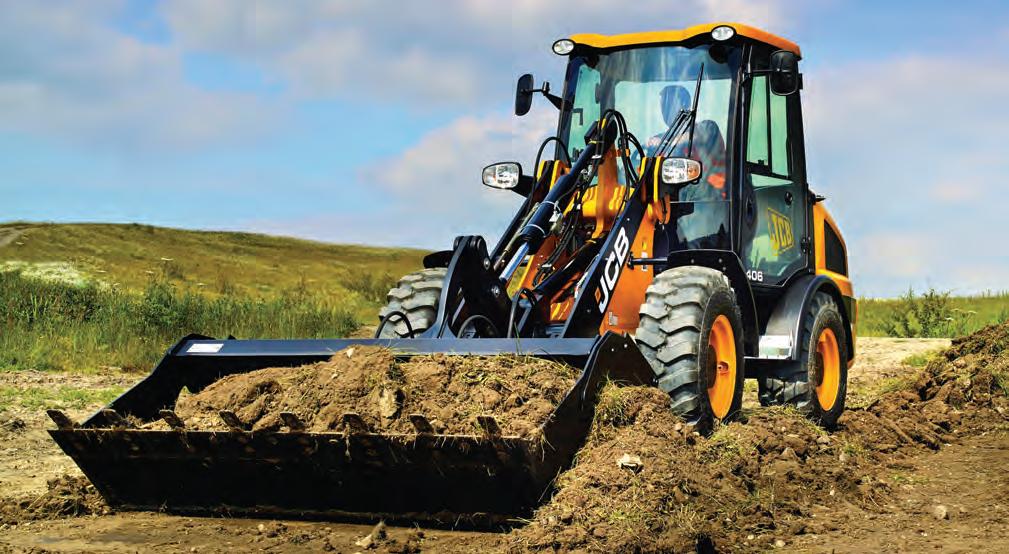
4 minute read
POWER AND ACCURACY
JCB’s TM420 Telescopic Wheel Loader has a maximum lift capacity of 4100 kilograms.
The industry was consulted during the development of the wheel loader, to better understand operator needs.

JCB’S TM420 TELESCOPIC WHEEL LOADER PROVIDES A COMBINATION OF FEATURES, INCLUDING THOSE OF A TRADITIONAL TELEHANDLER, TO PROVIDE A FLEXIBLE AND DURABLE WHEEL LOADING SOLUTION.
As National Product Manager JCB CEA Deon Cope explains, creating a blend of existing products has led to the development of the flexible TM420 Telescopic Wheel Loader.
“The TM420 is a crossover between a wheel loader and a telehandler, by combing the two you get a lot of the positives without all of the negatives,” Deon says.
Featuring a maximum lift height of 5.45 metres and maximum lift capacity of 4100 kilograms, the TM420 Telescopic Wheel Loader provides users with the capability of doing difficult lifts.
“It also has the ability to load over greater heights. This helps operators to load hoppers, high side trucks and trommels,” Deon says. “Having a telescopic arm is a massive advantage over a conventional wheel loader, as they would require a high lift arm or high dump / toe tip bucket, both of which can have their own challenges when operating.”
To support its lifting limits, the TM420 Telescopic Wheel Loader contains a purpose-built engine. Deon says JCB’s production process aims to ensure that operators can have an engine platform which can stand the test of time.
“Unlike a lot of other manufacturers who rely on third party components for their engine and drivelines, JCB has designed the driveline to suit the machine, rather than design the machine to suit the driveline. With a JCB engine, transmission and axles, the
wheel loader is designed to handle heavy workloads.
“It runs the JCB engine, matched with the JCB transmission, providing greater synergies and performance between the driveline and then through to the JCB axle.
OPTIMISING ERGONOMICS
The TM420 Telescopic Wheel Loader features an original cabin designed purely for operator comfort.
Referred to as the Command Plus design, the layout was first launched with the wheel loader platform.
Deon says that industry members were consulted during the design phase to find a balance between comfort and ease of operation.
“JCB has spent thousands of hours designing a cab around the operator, which included testing with industry operators,” Deon says.
“The result was a focus on ergonomics, such as seat comfort, hand placement, user interface. The cab has been developed with the operator in mind. People talk about converting automotive cabs for construction machinery, but JCB has designed its own architecture so that the cabin is not only ergonomic and comfortable, but also durable and rugged.”
A seamless glass design also offers unobstructed vision for operators who are handling loads. This is complemented by the boom positioning, which is featured in line with the centre of the machine, rather than on the side of the cabin.
The cab also avoids a reliance on touch screens, allowing operators to use the screen layout without using dirty hands.
Deon says that safety has also been incorporated into the design of the TM420 Telescopic Wheel Loader.
“There is a feature called adaptive load control, as the machine reaches its limit of stability, adaptive load control proportionally slows the boom speed and the hydraulics stop softly, this is a patented system and is only offered by JCB,” he says.

REDUCING OWNERSHIP COSTS
The TM420 Telescopic Wheel Loader design aims to reduce downtime for operators, for both maintenance and re-fuelling.
As Deon explains, two aspects help to improve the experience for the operator, while reducing the reliance on after sales support.
“The big thing here is commonality between parts. If users are operating machinery which has a JCB engine and they have other JCB machines, there is commonality between the filters, the oils and the servicing intervals. All of which is very convenient,” he says.
“JCB machines are also fuel efficient, the JCB engine has an advanced cylinder head design, which was developed in 2014.
“Fuel emissions are treated at the cylinder head, there is a more efficient burn at combustion, removing the need for a diesel particulate filter (DPF) on T4i engines. This also removes the need for DPF maintenance”.
Deon says that at its core, the TM420 Telescopic Wheel Loader’s performance can be summarised with just two words.
“With JCB machines, users have plenty of power, while also having the accuracy of hydraulics particularly when lifting at height,” he says.

TM420 Telescopic Wheel Loader contains a purpose-built JCB engine.
For more information, visit: www.jcb.com










